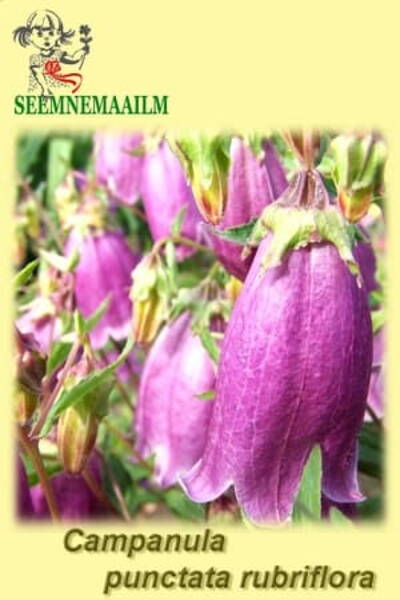Your shopping cart is empty!
Spotted bellflower "Rubriflora"
Spotted bellflower "Rubriflora" - Campanula punctata.
Captivating with its natural charm, touching and tender bell - the plant is fragile, but without it it is difficult to imagine a modern flower garden. At the very peak of flowering, the entire plant is covered with large flowers that will attract admiring glances from afar.
It also looks impressive when decorating containers and flowerpots. Good in rock gardens, suitable for cutting.
Flowering plant height: 25 cm.
1.0 g = 14,000 seeds.
Agrotechnics.
It reproduces well not only by seeds, but also vegetatively, by root offspring. There are many garden forms with a variety of colors and flower shapes, undersized and tall forms.
Sowing is done in April-June in open ground or in March for seedlings. Seeds are placed on the surface of a moistened and slightly compacted substrate, without covering them. Crops are sprayed from the sprayer and covered with glass, periodically it will be necessary to remove condensate (drops of water) from the glass. For friendly germination of seeds, light is needed (but not direct rays of the sun), as well as a temperature of + 16 + 18 ° C. Shoots appear in 15-21 days. In the phase of 1-2 true leaves, the seedlings swoop down on seedling beds. In the phase of 5-6 true leaves, the plants are planted in a permanent place at a distance of 25-30 cm.
Care: prefers any well-drained, non-acidic, moderately moist soil in full sun or partial shade. Responsive to the introduction of lime. In one place it can grow 3-5 years.
Flowering: June-August. Flowering is abundant and long. In order to prolong the life of the bell, it is necessary to cut the peduncle after flowering to form a new young rosette.
Use: group plantings, mixborders, rock gardens, for cutting. Pairs well with mantle, geranium, sunflower, carnation, as well as roses and ornamental grasses.
Winter-hardy. But after a winter with little snow, it may not bloom well, so preventive shelter is recommended. Winter hardiness zones: Z5 - Z9.

Spotted bellflower. Bot.syn.: Campanula nobilis Lindl.
Captivating with its natural charm, touching and tender bell - the plant is fragile, but without it it is difficult to imagine a modern flower garden. At the very peak of flowering, the entire plant is covered with large flowers that will attract admiring glances from afar.
It also looks impressive when decorating containers and flowerpots. Good in rock gardens, suitable for cutting.
Flowering plant height: 25 cm.
1.0 g = 14,000 seeds.
Agrotechnics.
It reproduces well not only by seeds, but also vegetatively, by root offspring. There are many garden forms with a variety of colors and flower shapes, undersized and tall forms.
Sowing is done in April-June in open ground or in March for seedlings. Seeds are placed on the surface of a moistened and slightly compacted substrate, without covering them. Crops are sprayed from the sprayer and covered with glass, periodically it will be necessary to remove condensate (drops of water) from the glass. For friendly germination of seeds, light is needed (but not direct rays of the sun), as well as a temperature of + 16 + 18 ° C. Shoots appear in 15-21 days. In the phase of 1-2 true leaves, the seedlings swoop down on seedling beds. In the phase of 5-6 true leaves, the plants are planted in a permanent place at a distance of 25-30 cm.
Care: prefers any well-drained, non-acidic, moderately moist soil in full sun or partial shade. Responsive to the introduction of lime. In one place it can grow 3-5 years.
Flowering: June-August. Flowering is abundant and long. In order to prolong the life of the bell, it is necessary to cut the peduncle after flowering to form a new young rosette.
Use: group plantings, mixborders, rock gardens, for cutting. Pairs well with mantle, geranium, sunflower, carnation, as well as roses and ornamental grasses.
Winter-hardy. But after a winter with little snow, it may not bloom well, so preventive shelter is recommended. Winter hardiness zones: Z5 - Z9.

Spotted bellflower. Bot.syn.: Campanula nobilis Lindl.












